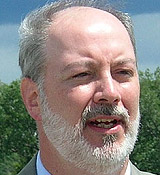
EPA's Greenhouse Plan Protects Park, Sets Global Pace
Monday, August 17, 2015
By: John F. Sheehan - Adirondack Council Communications Director
This blog first appeared in the Adirondack Almanack on August 17, 2015.
 On August 3, the U.S. Environmental Protection Agency (EPA) announced it had set tough new standards for controlling greenhouse gas emissions from fossil-fuel power plants. This final Clean Power Plan would reduce carbon emissions by 32 percent below 2005 levels by 2030. That is a nine-percent deeper cut than EPA’s preliminary plan, announced last year.
On August 3, the U.S. Environmental Protection Agency (EPA) announced it had set tough new standards for controlling greenhouse gas emissions from fossil-fuel power plants. This final Clean Power Plan would reduce carbon emissions by 32 percent below 2005 levels by 2030. That is a nine-percent deeper cut than EPA’s preliminary plan, announced last year.
The final plan sets carbon pollution reduction standards for power plants but allows all states the flexibility to design their own plans for meeting the pollution targets. That means each state can design its own program for meeting the federal emissions limits, like the successful acid rain program the Adirondack Council helped design and put in place. That will help to keep costs down and compliance high, while allowing companies the flexibility to try new technology and new fuels.
For example, industry experts predicted at the beginning of the federal acid rain program that compliance would cost power companies about $7 billion per year. That estimate was based on the EPA’s old method of dictating specific control technologies. By giving states the room to work with power companies to find the fastest, cheapest reduction methods, the EPA said the cost of compliance fell to less than $700 million per year, or about 10 percent of early estimates.

Spruce Grouse
Photo by: Larry Master, masterimages.org
Meanwhile, the savings were huge in terms of improved human health (less lung disease as smokestack pollution declines) and avoided damage to buildings, monuments, outdoor sculptures, and automobile finishes. Federal estimates showed that the savings in terms of human health alone at $20 for each dollar spent on compliance.
The Clean Power Plan is aimed at reducing greenhouse gases, which threaten to cause catastrophically dramatic changes is climate around the world. In the Adirondack Park, we stand to lose much of our biological diversity if the Park becomes too warm for the boreal forests (spruce and fir, with mossy ground) that dominate the northern Adirondacks, Canada, Alaska, and Siberia. Without strong intervention, scientists predict our annual temperatures could match those of Richmond, Va.
Under such conditions, experts predict that the Appalachian-style temperate hardwood forests of the southern Adirondacks would migrate farther north and overtake the current boreal habitat. We would also see reduced numbers of species that like boreal forests, including the endangered spruce grouse, white-throated sparrow and boreal owl, along with fishers, snowshoe hares and lynx.

Fisher
Photo by: Larry Master, masterimages.org
The Park’s communities are largely built along rivers and lake shores, so a warmer, stormier future with bigger floods and longer draughts would endanger people, property, public services, and tourism.
States have until September 2016 to submit plans. It is unclear whether all will meet that deadline. Although he has no authority to exempt them, U.S. Senate Majority Leader Mitch McConnell, R-Ky., has publicly advised governors who are opposed to the plan that they should refuse to comply. Kentucky is a coal producer. Coal’s high carbon emissions would make it unpopular under the new greenhouse gas rules.
The EPA has the authority to impose generic plans on states that refuse to comply with the 2016 deadline.
One big side-benefit of the Clean Power Plan will be the new acid rain and smog reductions that it creates. By improving the efficiency and reducing fossil fuel consumption to meet the new carbon standards, power plants will also be curbing their emissions of sulfur, nitrogen, fine particles, and mercury. That is great news for the Adirondack Park.
Finally, the program will allow the United States to exhibit leadership on climate change at the 2015 United Nations Climate Summit in Paris.
|
Would you like to comment on what you've read or viewed? We'd love to hear from you. Please click to send us a message.
Born and raised in Troy, NY, John Sheehan is a graduate of Catholic Central High School and the State University at Albany (1985; BA). Before joining the Council's staff in 1990, John was the managing editor of the Malone Evening Telegram, just north of the Adirondack Park. Prior to that, he worked as journalist for the Troy Record, (Schenectady) Daily Gazette, Watertown Daily Times and Newsday. John is a regular guest lecturer at several New York colleges and universities, including Colgate University, Hobart & William Smith College, Hamilton College, Rensselaer Polytechnic Institute, Union College, Siena College, SUNY Albany, SUNY Binghamton, SUNY College of Environmental Science and Forestry (Syracuse), and SUNY Potsdam. He has also addressed dozens of local organizations including local Rotary and Kiwanis clubs and chambers of commerce, scientific societies and community forums. John and his wife Deborah live in Albany and are seasonal residents of the Adirondack Park. Their daughter Hannah attends Albany public schools. |
||





